|

Page 1 2
3 4 5
6 7 8
9 10
Monday, 13 November. After breakfast at the hotel, we left for Cordoba. It was overcast
and rainy when we arrived, but the sun came out within an hour. The bus dropped us off at the
Roman Bridge (Calahorra) spanning the Guadalquivir River. This bridge is 2000 years old and
once formed part of the Via Augusta.
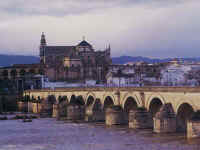
Roman bridge |
We walked down one side of the huge Cathedral/Mosque (Mezquita) to a coffee shop
where Angel gave us "20 minutes" of free time. (With him, that meant at least 40.) Jane and I
walked back to the Roman Bridge for a better look. We also examined the Roman Gate on the
north end of the bridge. The original mosaic paving under the gate is still intact.
We passed some interesting old Moorish palaces along the way. We then
rejoined the group at the coffee shop well before Angel led us to meet the local
guide for our tour of the Mezquita.
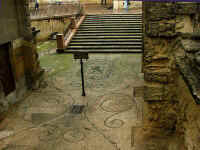
Mosaics beneath Roman gate |

Old Moorish palaces |
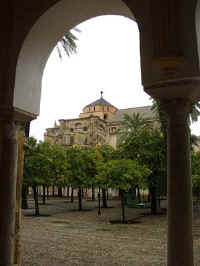
Entering the Mesquita
|
When the Moors conquered Spain in 711 A.D., they made Cordoba their capital. Initially
they shared the older Visigoth Basilica of St. Vincent on this same site with Christian
worshipers. Then in 756 A.D. they began construction of the present mosque, using materials
from the basilica.
Over the next three centuries, successive rulers added new sections to the
mosque until it was several times its original size. During this time, Cordoba grew to become the
largest and most cultural city of Europe. It had a population of 600,000 when neither Paris nor
London had even 50,000 inhabitants.
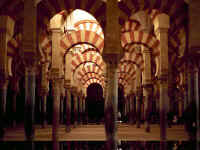
Unique double arches
in the old Mesquita |
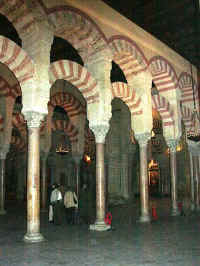
More double arches |
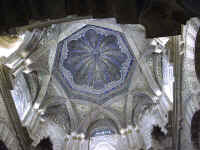
Interior of one of
the Mesquita's domes |
When the Christians conquered Cordoba in 1236, they converted the mosque into a
Christian cathedral, and the Royal Chapel was added soon after. Then in 1523 Charles V, over
strenuous objections from the city, decided to build a new Christian cathedral inside the original
mosque.
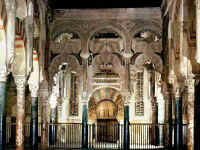
Catholic tabernacle |
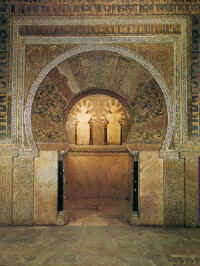
Tabernacle (closer) |
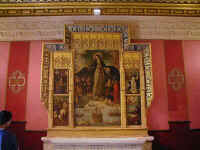
Catholic altar |
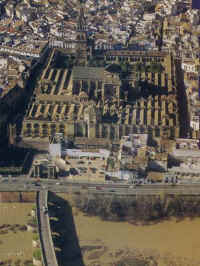
Aerial view of Mesquita
|
This project took 234 years to complete. Fortunately, only a relatively small portion of the
mosque was destroyed in the process. Really the only way to get a proper
perspective on the dimensions of the Mezquita (and the cathedral within it)
is with an aerial view, provided here. It also shows the old Roman
gate and part of the bridge.
Leaving the mosque, we walked through the picturesque old city, including the
Juderia.
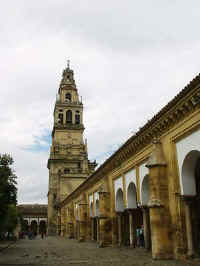
Former minaret of Mesquita |
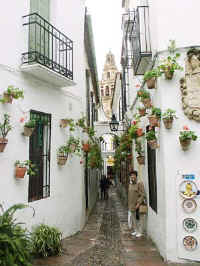
Jane & Giralda tower |
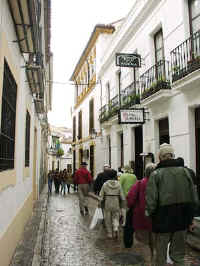
Our group in Juderia |
We finally
passed through the old Arab city wall to where our bus was waiting. After a short drive around the city,
the bus took us to a restaurant on a hill out in the country. We enjoyed the beautiful view while
we had lunch. As we drove back through Cordoba, we crossed a bridge parallel to the Roman
Bridge and could see its full expanse for the first time.
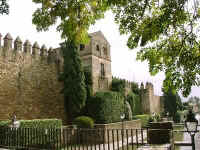
City wall built by Arabs |
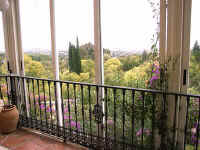
View from restaurant |
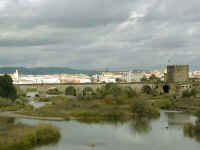
Roman bridge |
It was raining again as we headed back toward Torremolinos. At the rest stop en route,
Angel introduced us to the lamumba, a concoction of brandy and hot chocolate milk. When we
arrived at the Nautilus Hotel about 5:30, our room was ready and our luggage was there. We
finally were able to unpack for a long stay. We had dinner at the hotel with Tom and Kyoko and
enjoyed a relaxing evening.
Page 1 2
3 4 5
6 7 8
9 10
|